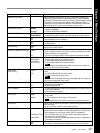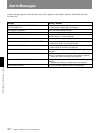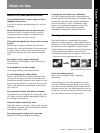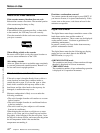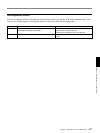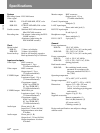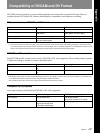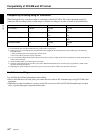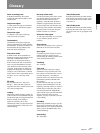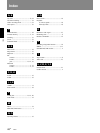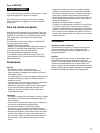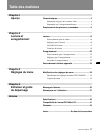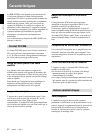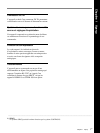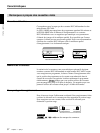
Appendix
Appendix 47
EN
Glossary
Audio recording mode
In the DVCAM format, the sound is
recorded in either 16bit (Fs48k) or 12bit
(Fs32k) mode.
Component signal
A video signal consisting of a luminance
signal (Y) and two chrominance signals
(R–Y, B–Y).
Composite signal
A composite video signal containing
video, burst and sync signals.
Condensation
Condensation of moisture on the tape
transport mechanisms of VCRs including
the head drum. If moisture condenses on
the head drum, the tape adheres to the
drum and causes malfunction.
Drop frame mode
In NTSC format, the actual number of
frames per second is approximately 29.97,
while that for SMPTE time code is
specified as 30. Drop frame mode is a
mode in which time code is advanced in
such a way that the difference in frame
value between real time and time code is
corrected. In this mode, two frames are
skipped at the beginning of each minute,
except for every tenth minute, so that the
frame value for time code matches that for
real time. See also “Non-drop frame
mode”.
EE mode
EE is an abbreviation of “Electric to
Electric”. Video and audio signals are
supplied to the VCR’s internal circuits, but
not to the recording heads.
Loading
When being loaded, the tape is pulled out
of the cassette case and threaded along the
specified tape path and wrapped round the
drum to be ready for recording or
playback. Generally, this is done
automatically when you place the cassette
at the cassette entrance of the VCR. Also
called threading.
Non-drop frame mode
A mode of advancing time code in such a
way that the difference in frame value
between real time and time code is
neglected. Using this mode produces a
difference of approximately 86 seconds
per day between real time and time code,
which may cause problems when editing
programs in units of seconds using the
number of frames as a reference.
Reference video signal
A video signal consisting of a sync signal
or sync and burst signals, used as a
reference.
Superimpose
To put a set of characters onto a picture so
that both can be seen at the same time.
Sync signal
A reference signal consisting of vertical
and horizontal sync signals used for
synchronizing the scanning patterns of the
video camera and the monitor.
Threading
See “Loading”.
Time code
Signals recorded on the tape to supply
information on tape position such as the
hour, minute, second and frame, to assist
in setting edit points or searching for
particular scenes. This VCR can cope with
both DF (Drop Frame) and NDF (Non
Drop Frame).
On this VCR, the time code is recorded
sequently from “00:00:00:00,” from the
beginning of the tape. However, if there is
a blank section on the tape, time code is
reset and recorded from “00:00:00:00”
again from the section just after the blank
section. If the time codes are out of
sequence, you may not be able to execute
correct editing.
Unloading
When being unloaded, the tape is put into
the cassette case from the tape path of the
VCR. Generally, this is done automatically
when you press the EJECT button. Also
called unthreading.
Unthreading
See “Unloading”.
12bit (Fs32k) mode
In the DVCAM format, the 12bit (Fs32k)
mode separates the audio area into 2 parts.
You can record two kinds of audio, stereo
1 and stereo 2.
16bit (Fs48k) mode
In the DVCAM format, the 16bit (Fs48k)
mode uses the whole audio area to record
one stereo track. You can get higher sound
quality.



